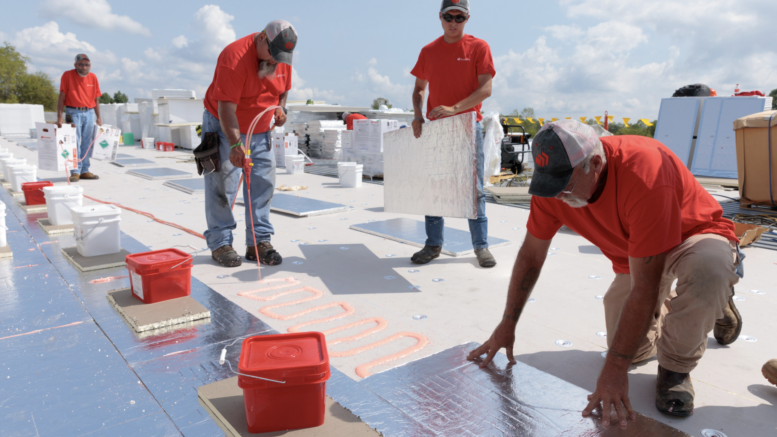If we have learned anything from roofing in recent summers, it’s that you can’t be too cautious when preparing to work in summer heat. Last summer ranked among the hottest on record, according to data from the National Aeronautics and Space Administration and the National Oceanic and Atmospheric Administration, and we should prepare for the same in 2023. Be extra cautious when it comes to managing a roofing project in extreme heat.
The summer months are prime roofing season, with longer daylight hours, less precipitation and clear skies. However, high temperatures and humidity can present risks to your crew’s health and safety. Mitigating risk and ensuring your crew is safe and comfortable when planning for and managing a roofing project is vital. The following are tips to help manage your project safely and efficiently during the hottest months of the year with less risk to your most valuable asset: your crew.
Crew Safety
• Let building owners and occupants know that your crew will start early each day. Begin your work days as soon as conditions are favorable.
• Do not skip protective gear because of the heat. Vests, hard hats and fall protection gear help prevent injuries. Period.
• Wear all cotton, light-colored, loose and comfortable clothing. Synthetic fabrics like nylon and polyester may accumulate static charge more easily. Do not wear shorts.
• Wear safety glasses with UV protection and apply water-resistant sunscreen as needed throughout the day — ideally 30 SPF or higher.
• Stay hydrated. Keep a cooler nearby with plenty of water. Take periodic breaks, preferably off the roof and in the shade. Assemble a tent for a makeshift break area if necessary. Keep smoking to a minimum, and only in a designated break area.
• Use care when removing release liners and discharge static from your body before handling solvent-based adhesives and primers. Also, use care when moving equipment and materials on the roof. Try not to drag insulation boards, membranes, electrical cords, or even your feet across insulation board facers.
• Keep in mind that solvent vapors are generally heavier than air, so they may concentrate in low-lying areas and can be ignited by sparks, heaters, electrical motors, flame, smoking, etc.
• Train your team to recognize the signs of heat exhaustion and heat stroke in themselves and their fellow roofers. Open communication is key to being able to act on any suspicion of heat-induced illness. Have a planned exit from the roof. If anyone experiences any of the following symptoms — dizziness, fatigue, headache, nausea rapid heartbeat, confusion — move them to a safe place and seek immediate medical attention.
Protection of Roofing Materials
• Never store materials or equipment in direct sunlight, especially flammable materials, pressurized canisters, and spray equipment and hoses. Keep adhesives, primers, and sealants covered with a tarp — preferably in the shade — and keep them separated from ignition sources, other materials, tools, equipment, and waste or debris. Remove these materials from the tarped area just before use, and only bring out as much as you expect to use.
• Review technical information sheets often to ensure proper application based on current weather conditions. Open (“pot life”) times, coverage rates and flash-off rates for solvent-based products vary depending on substrate type, ambient temperature, exposure to sunlight, relative humidity and dew point.
• Emphasize the benefits of spray adhesives to the customer in the planning stages, so your team can work smarter, not harder, and with less disruption to building occupants. Spray adhesives from canisters include less volatile organic compounds and solvents, are often faster to apply, and carry fewer health risks than many conventional roofing materials. Spray adhesives can save money in the long run and will allow your crew to decrease their time spent in the sun.
When planned correctly, managing a roofing project safely in the summer is not complex, but it is extremely important for managers to remain diligent. It requires dedication to your crew, consistent awareness of the rising temperatures, and care for all of the individuals involved. Attention to the well-being of your team can make or break their safety and the success of the project. So, consider these tips in the planning and execution stages of your next roofing project, and ensure you do everything you can to manage and educate your team on what a safe and efficient summer roofing project requires.
About the author: Robert Anderson, CSI, CDT, is Regional Account Manager for Holcim Building Envelope Division. He is responsible for promoting Holcim’s premium roofing system offerings to building owners, building envelope consultants, and the architectural community. Over more than 20 years in the industry, he has held many other valued positions within the company, including Estimating Manager, Metal Product Manager, Regional Business Manager, and Building Envelope Solutions Manager. For more information, visit holcimelevate.com.



Be the first to comment on "Tips For Managing a Roofing Project in the Summer Months"